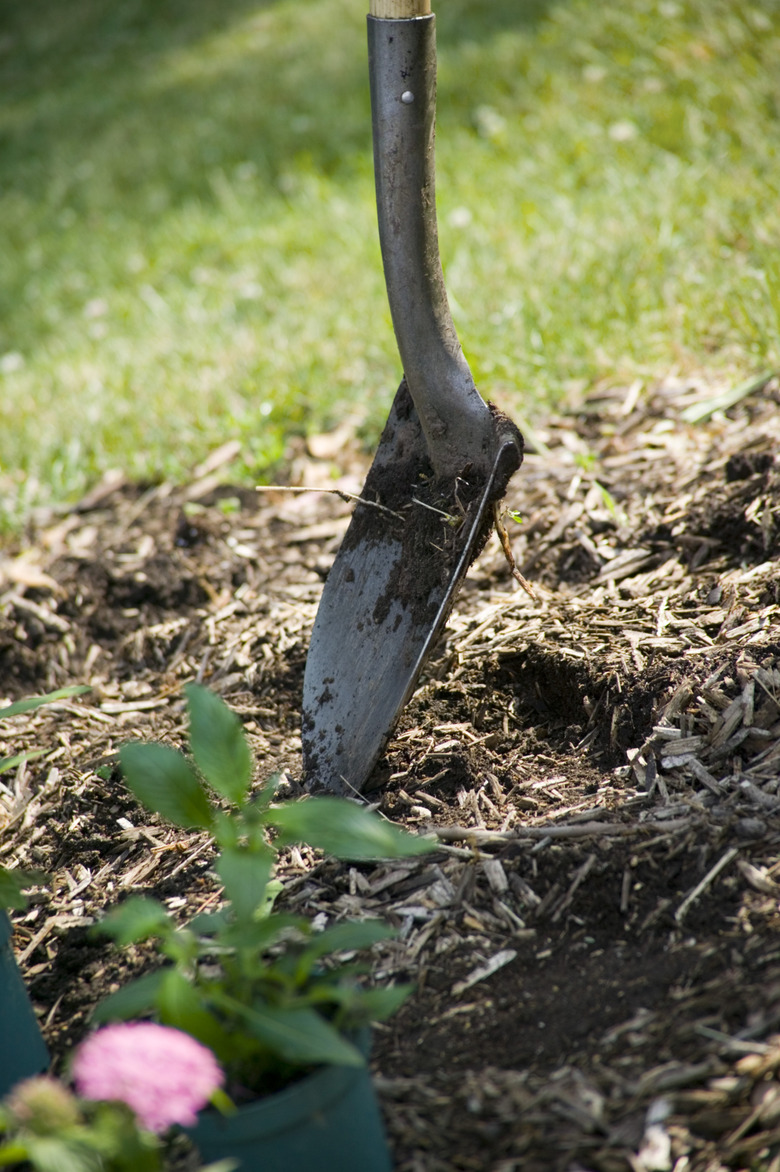How To Keep Mulch In Place
Mulch is rarely permanent. A good, properly prepared organic mulch will break down over time. According to the Texas A&M University Extension, the best mulches are organic, and they improve the structure of your soil year by year.
Mulch is rarely permanent. A good, properly prepared organic mulch will break down over time. According to the Texas A&M University Extension, the best mulches are organic, and they improve the structure of your soil year by year. Inorganic mulches don't break down as readily, but they may still require annual refreshing. However, if your mulch is often scattered or in poor shape, consider changing your approach to mulching.
Step 1
Try a living mulch. Since living mulches are growing plants, they are naturally anchored in the soil. This type of mulch can be used to supply nutrients to the soil and to prevent weed growth during an ordinarily fallow time. This type of mulch is better suited to gardens and fields than to flower beds.
- Mulch is rarely permanent.
- Inorganic mulches don't break down as readily, but they may still require annual refreshing.
Step 2
Apply your mulch to a proper depth, usually 2 to 4 inches. The Clemson Cooperative Extension suggests you should err toward the minimum depth if you are using a mulch that tends to mat together, and install a deeper layer if you are using a coarse mulch. A sparse amount of mulch will not prevent weed growth, which will further displace your mulch and prevent it from doing its job effectively. Thin applications of mulch may lead to bare spots around plants even when the mulch is minimally disturbed. The weight of the mulch will help keep deeper levels in place, and the greater volume will give the mulch uniform coverage and appearance.
Step 3
Use a heavier material — or one with more surface area — if strong winds or small animals tend to scatter your mulch. Inorganic mulches such as gravel or stone are considered a permanent form of mulch. These are best suited to locations where you have established plantings that are unlikely to change from year to year. The Clemson Cooperative Extension warns that stone mulches can reflect heat and add alkalinity to the soil, which may cause problems with some plants.
- Apply your mulch to a proper depth, usually 2 to 4 inches.
- The Clemson Cooperative Extension suggests you should err toward the minimum depth if you are using a mulch that tends to mat together, and install a deeper layer if you are using a coarse mulch.
Step 4
Anchor landscape cloth and plastic mulches. These large sheets of material tend to be lightweight and easily dislodged by animals, wind or maintenance around your plants without an added weight to hold them to the ground. Cover the corners, the edges or the full sheet of material with rocks, soil or a secondary mulch to prevent the sheets from becoming dislodged. Such a cover will also disguise the appearance of a plastic mulch, if you find it objectionable.
Step 5
Adjust the depth of your mulch application to fit the season. If you add a full blanket of mulch in early spring, some seeds may not germinate and some plants may not be able to penetrate the layers. The 1-800-Mulch-Pro website suggests you follow these guidelines: Wait until late spring or early summer to mulch your landscaping, and pull back the mulch from areas where plants are emerging. Mulch your garden mid-summer. Mulch in the fall, to a depth of 5 inches, to provide winter protection to particular plants or to extend the time needed for plants to establish their root systems in a new location. Add a very thin layer — 1 inch deep — in winter to provide insulation to a plant bed.
- Anchor landscape cloth and plastic mulches.
- The 1-800-Mulch-Pro website suggests you follow these guidelines: Wait until late spring or early summer to mulch your landscaping, and pull back the mulch from areas where plants are emerging.
References
- Clemson Cooperative Extension; Mulch; Marjan Kluepfel, et al.; May 2008
- Virginia Cooperative Extension; Mulching for a Healthy Landscape; Diane Relf
- Ohio State University Extension; Mulching Landscape Plants; Dr. Mary Ann Rose, et al.
- Cooperative Extension System; An Organic Weed Control Toolbox; Mark Schonbeck; March 2010
